The Hx 750 is my favorite kit from Falco. It’s strong, smooth and relatively quiet. It’s also heavier and more expensive than the standard Hx 500. The best parts of this kit are its ability to offer regeneration and charge the battery pack when coasting down hills as well as its open source nature (you can use it with third party batteries). The downsides are that it doesn’t have regenerative braking, can feel jerky once you reach 20mph vs. cutting out slowly and the LCD control interface is large and clunky in the way it mounts. It’s not a perfect kit but the all black design, downtube battery canister and modular options make it a good fit for people who are working on custom projects. The direct drive motor will last for many years and is designed to reduce cogging, dissipate heat and offer responsive power when the rider is in pedal assist mode.
At the heart of this kit is a 750 watt direct drive (gearless) hub motor that you can either order on its own or built into a wheel size of your choosing (it can be spoked into 20″, 24″, 26″ or 700C to fit virtually any bicycle). The rims have angled holes to add strength to the spokes and are indented to reduce loosening over time. Considering that it’s gearless, this motor is actually pretty slim and light weight. It rides quiet but cuts out abruptly at 20mph (to honor US legal restrictions). I wish they could smooth this out because it can be a bit jarring and doesn’t happen on other kits I’ve tried. Many ebike motors use three hall sensors but Falco motor uses five and this smoothes out acceleration. I’m not sure if I could really tell the difference but the feature gets hyped up and the engineers at Falco are some of the pioneers in the space so I’m sure this motor will last well (and there’s a good warranty). While the motor coasts relatively smoothly when turned off it still suffers from some cogging (the magnets repel the stater and slow it down faster than a freewheel). Note that the motor output can be changed from high torque to high speed and adjusted to be responsive or more dull if you get the optional $50 USB dongle and download their software. Here’s a video overview with the founder explaining how it works.
There are lots of choices to make with this kit and one of them is which drive modes to activate. Falco offers something called “triple drive” that lets each system override the next: torque to cadence to throttle. I love that you get to choose from these options but it adds to the price and I couldn’t tell a huge difference from one mode to the next (aside from throttle). I also would have liked a throttle only mode at level zero vs. nothing… You can achieve this experience by turning the bike off so it felt like they missed an opportunity here. Also, their thumb throttle module is quite large and bulky.
The battery on this bike presents a few more options including size and configuration. The standard size is 36 volts of power and 11.6 amp hours of capacity which is a touch above average. It uses light weight, long lasting Lithium-ion cells and weighs ~5.5 pounds. You can upgrade this to a 48 volt pack that offers more power (as seen in the video review) and can propel the bike faster if you get the computer console option and an unlocked kit. I’d say, if you do a lot of climbing or weigh over 180 pounds the 48 volt option is worth considering. The next choice is whether to get a rear rack mounting battery or a downtube canister. I personally prefer the canister design because it keeps weight lower and distributes it more naturally across the frame. The 48 volt pack is super long and quite a bit heavier but it’s neat that it still mounts to the frame vs. rear rack). It’s also easier to remove for charging.
The cockpit on a bike with a Falco kit can be either extremely clean (no display, no throttle… only torque sensing assist) or cluttered and tricky to use. The wireless display is unnecessarily large and doesn’t tighten down very well (though I like that it’s removable). The plus minus switch works as intended and is connected to the console. I feel like they could have saved money (and saved me time) by not making it wireless as you still have to wire a throttle back to the battery and control system. If you get the console you’ll have to charge it every couple of weeks and it includes a separate wall plug. The twist throttle is standard but the trigger throttle is larger than I’d like and I’m not sure why. Also, in order to make the wireless bits work, this kit includes an extra little box that has to be zip tied onto the tubing of the frame and that just looks tacky.
The Falco Hx kits provide a lot of options for custom configuration, work with non-Falco batteries and can be unlocked for higher speeds. I enjoyed test riding the kit and appreciated how quiet, smooth and small it was but feel there are a few oddities to refine. Admittedly, I’m not the kind of person who builds ebikes from scratch but I could still appreciate the options and versatility of this kit. I also like how cool it looks in the all-black finish. It can be a little tricky to find online but the Electric Cyclery in Laguna Beach, CA carries it and will ship nationally in the USA. I didn’t see a big difference in torque sensing vs. cadence sensing (they both could have been smoother) but realize this kit has been growing over the years vs. launching with all of these options at once. The software really lets you dial things in but requires a $50 accessory and some screwing around… I can’t say whether it really changes the ride as my experience using it has been limited.
For the larger battery pack shown in the video of the recumbent bike, they use Lithium-ion Sanyo. You can contact Falco at [email protected] to get more information on this pack which costs ~$900.
Pros:
- Feels smoother and runs quieter than the Hx 500 kit from Falco E-Motors
- Can communicate wirelessly with optional computer console and with ANT+ heart rate monitors
- Offers cadence sensing pedal assist, torque sensing assist, trigger throttle or twist throttle
- Compatible with a wide range of batteries or you can get the Falco rear rack or canister designs
- 5-phase hall sensors provide a smooth ride with additional torque, motor is designed to run cool
- Uses 15 embedded sensors to measure motor current, power, voltage, temperature, magnetic field and torque
- Provides five levels of regen that reduce wear on brake pads and extends battery
- Optional computer displays speed, distance, trip time, battery voltage, battery capacity, battery current and heart rate (with ANT+ device sensor)
- Off-road kit available to achieve 20+ mile per hour speeds (have to buy this motor, cannot unlock later)
- Multiple activation sensors including throttle, crank sensor, torque sensor or combination
Cons:
- Trigger throttle box and display panel are large and less aesthetically pleasing than some other ebike systems
- The “off road” package is required to unlock higher top speeds and costs extra (hardware based, cannot unlock later if you get a regular kit)
- Have to charge the wireless display separately with additional plug attachment (batteries should last several weeks)
- Display panel attachment uses a quick release that doesn’t secure as well on smaller bars 25mm in diameter (may require rubber strips or extra padding)
- Older models have less smooth cut off at 20mph, firmware updates have improved this on newer models
- Wireless communicator box adds clutter to the system (required for wireless display)
Resources:
- Official Site: http://www.falcoemotors.com/
- More Pictures: https://goo.gl/photos/mXbF5iKcsXYoKiAB7

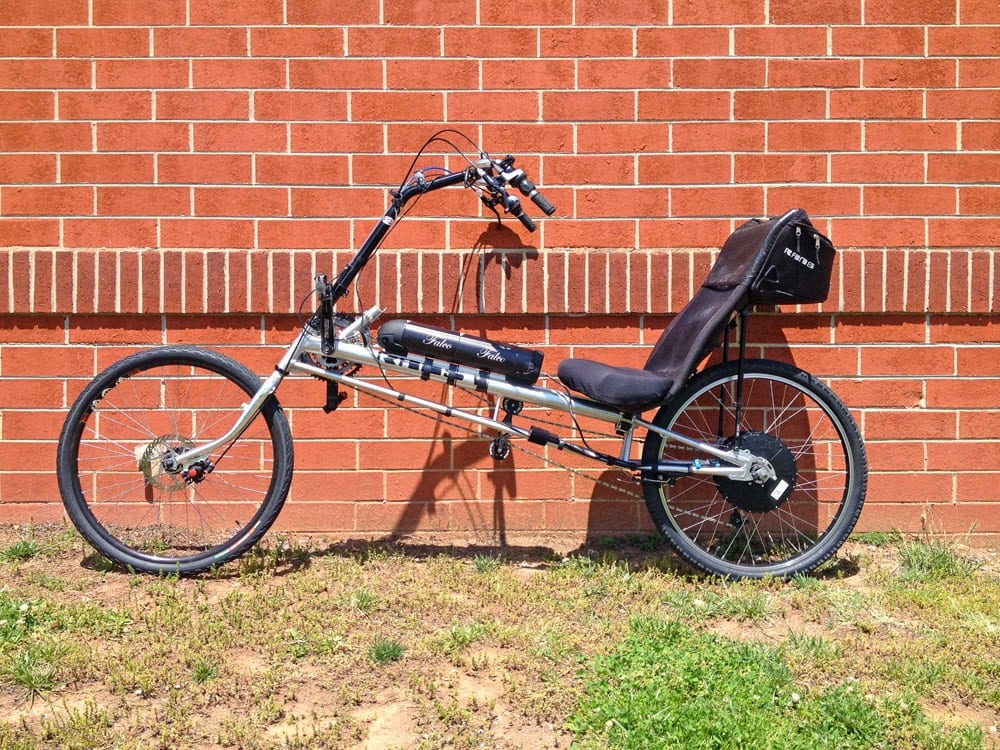
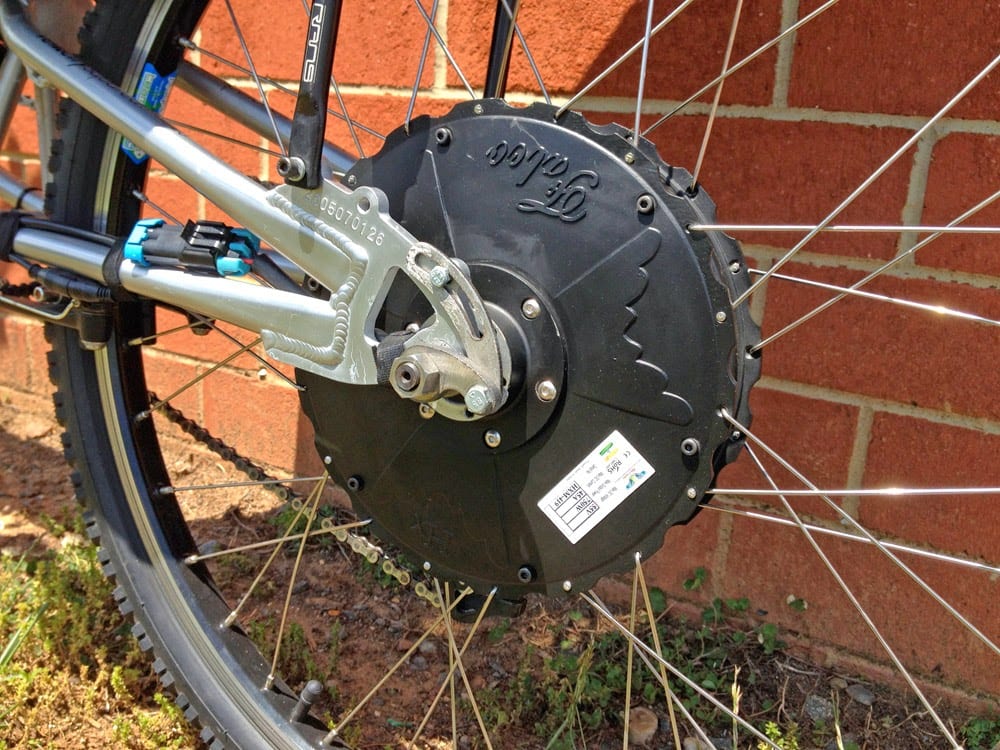
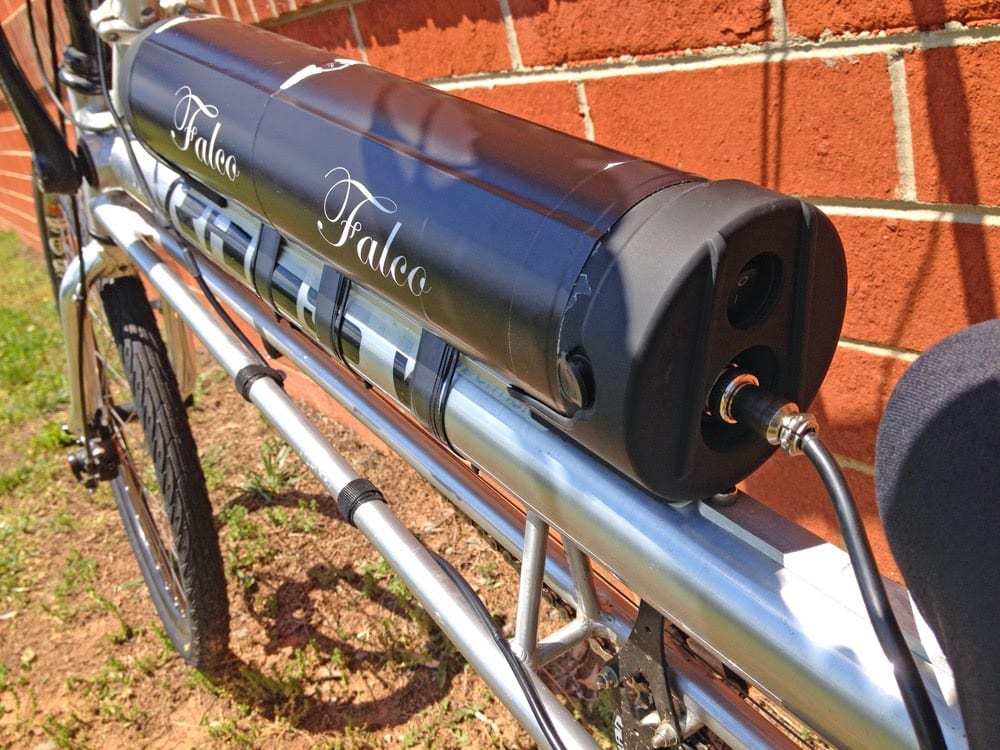


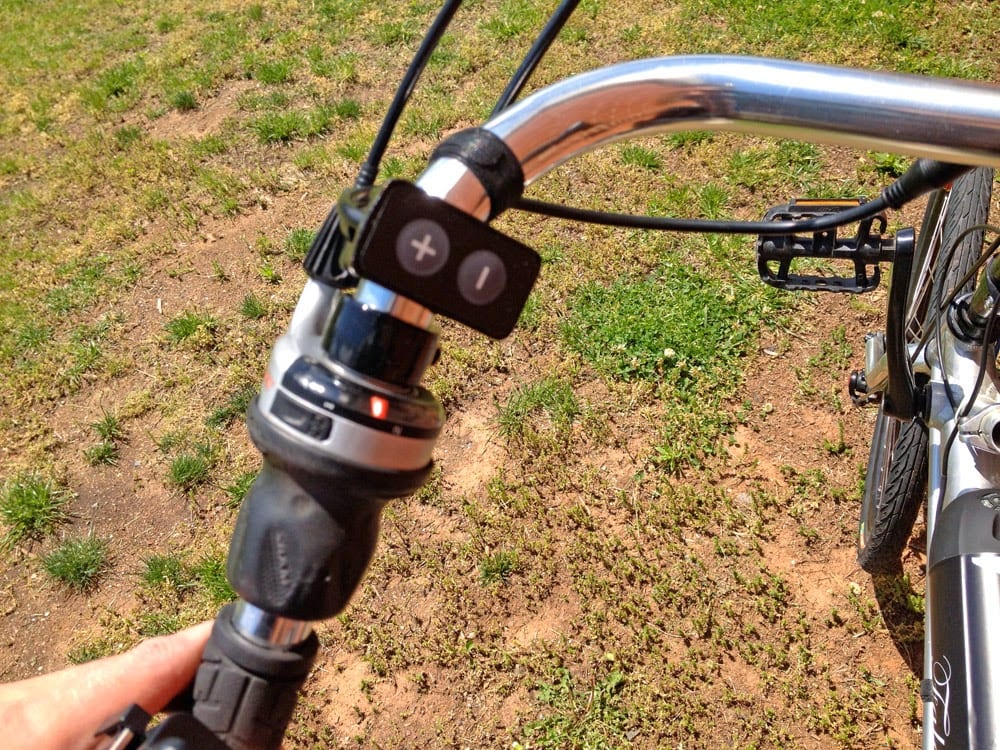
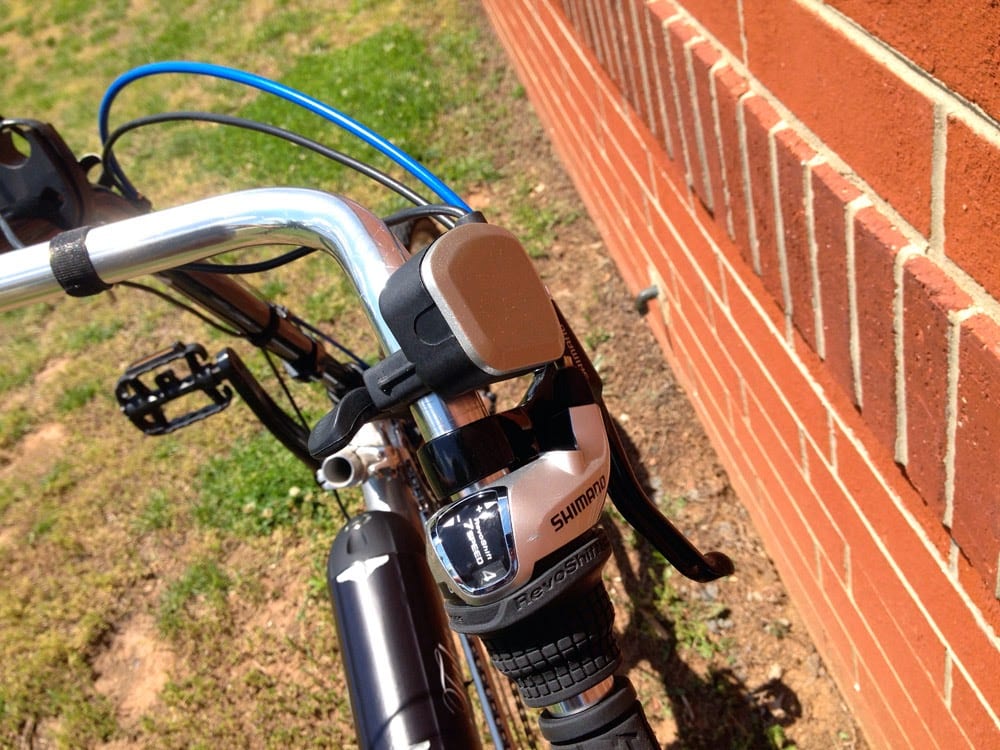
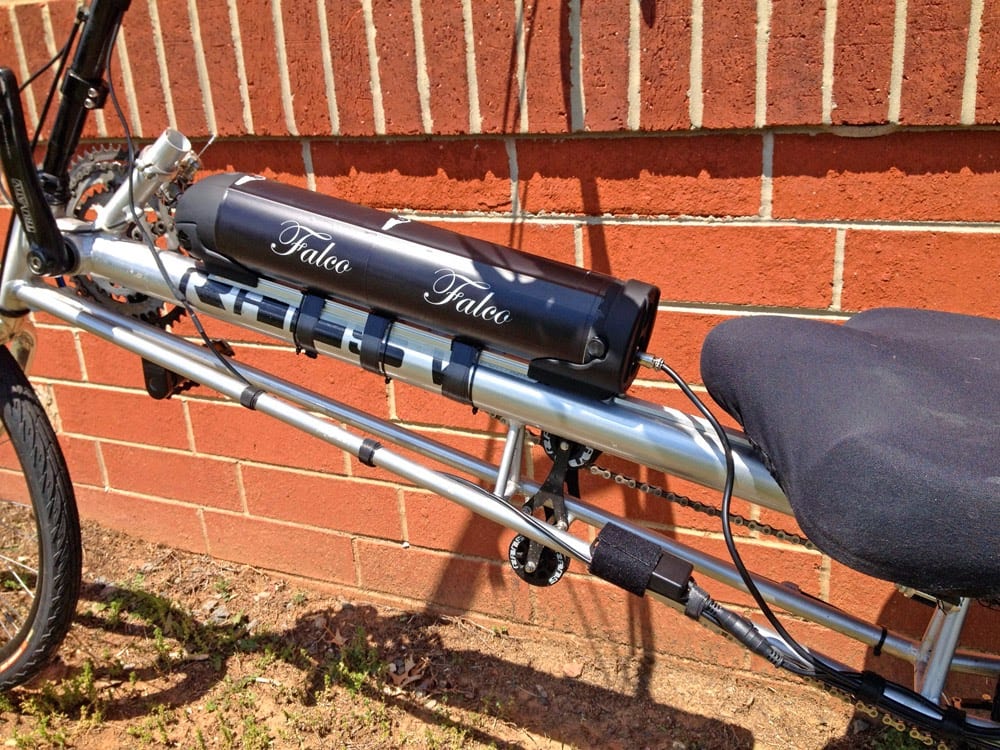
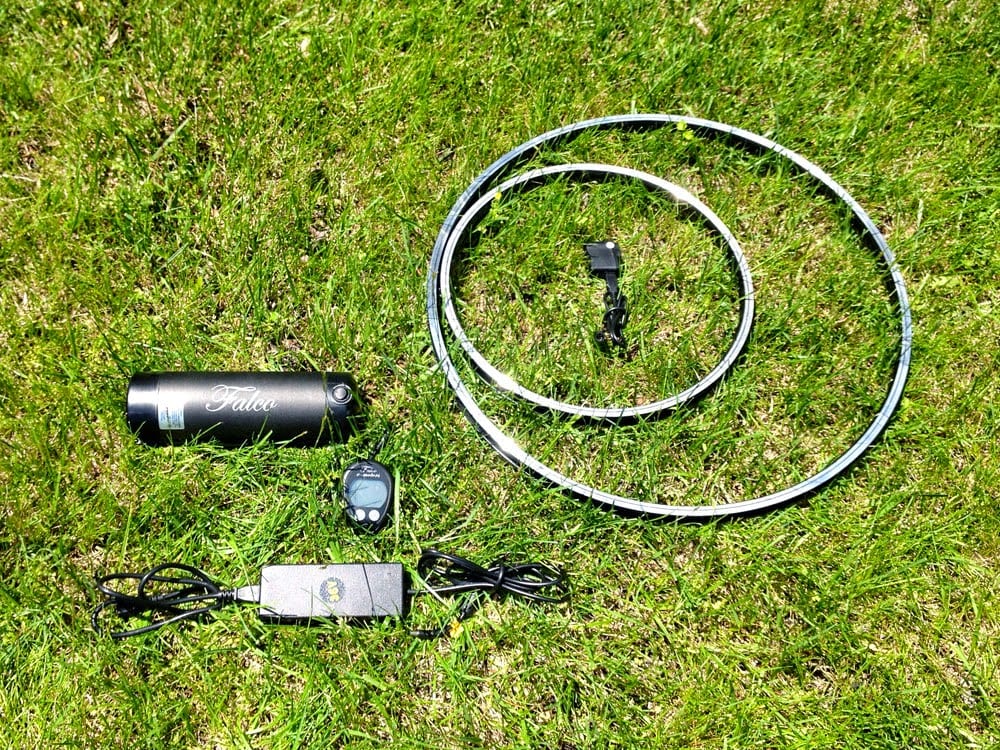

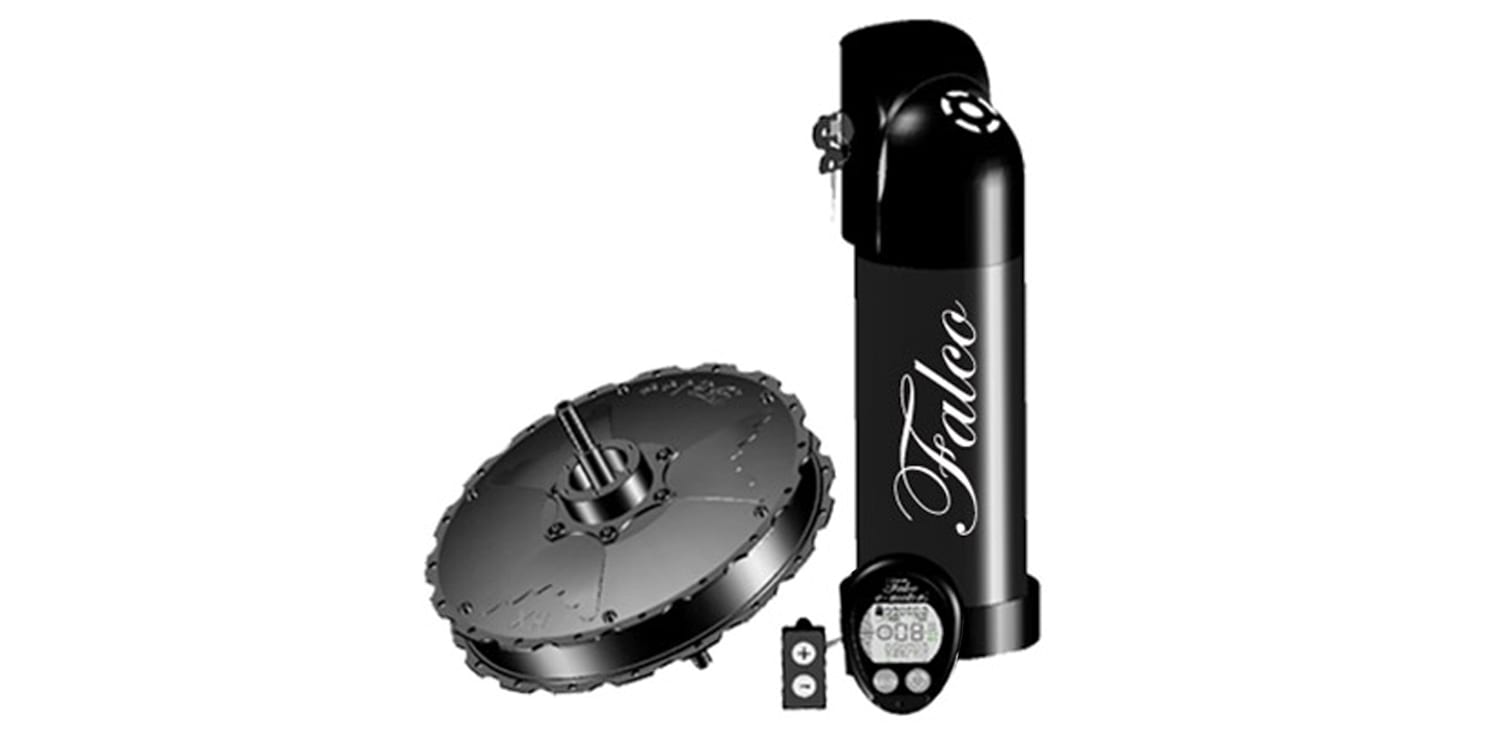
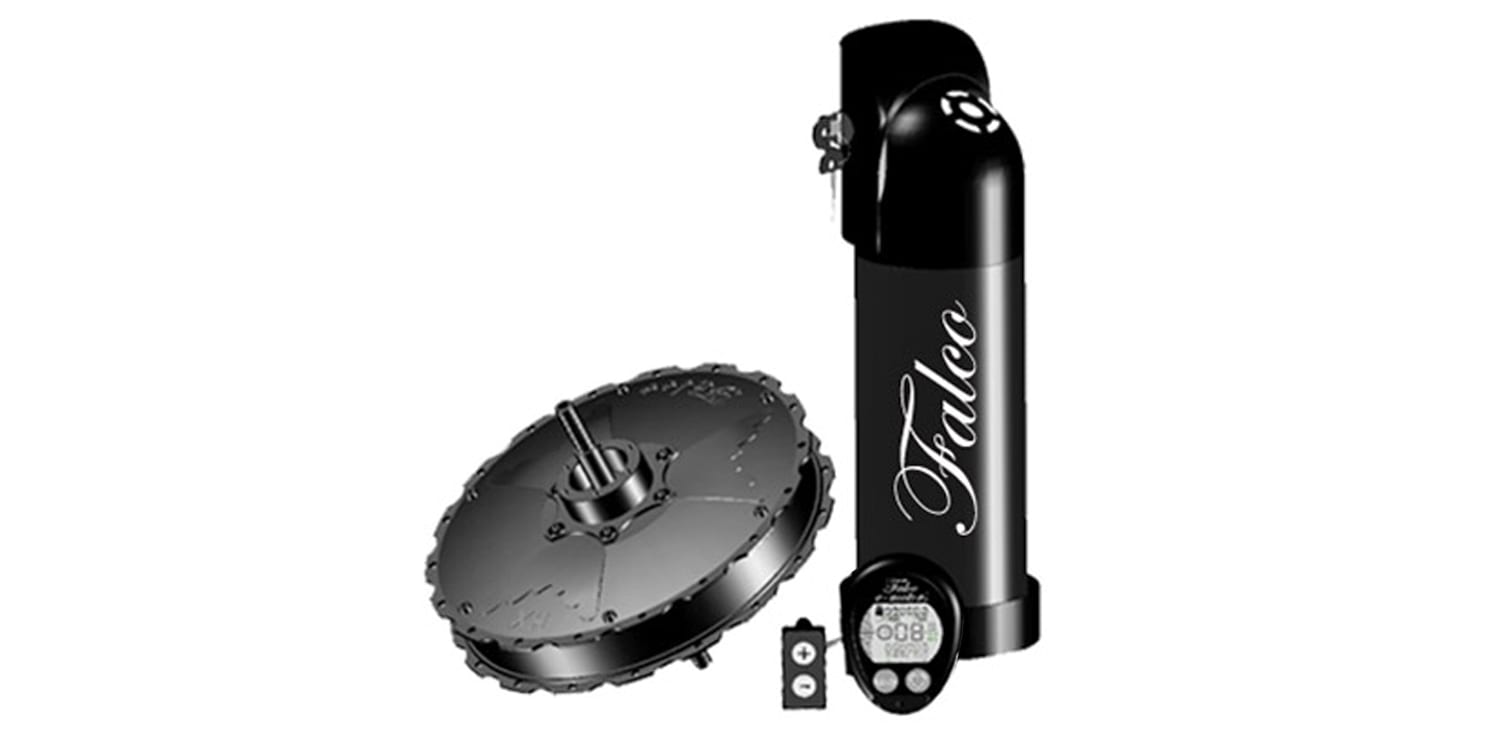
leek says
Does it, or doesn’t it, support regenerative braking? The article says it doesn’t, but the summary in “Pros” says it does.
Court Rye says
It features five levels of regeneration but that is activated through the display and the +/- buttons not the brake levers. I’ll update the summary to not say “braking” thanks for the heads up :)
JAMES says
I noticed you had what looked like two normal bottle racks together (or an extra long one) on your recumbent bike shown in the Falco 750w review., and you said they were 48V. The only 48V battery that I show offered (ie. at electricbicycleworld.come or ebikesofne.com) is the rear rack 48V setup. Where did you get that 48V pack and how many amp hours is it? I hope your response goes through to my email directlyt. Thanks.
Court Rye says
Hi James, you’re not the first person to ask this! The frame mounted bottle-style battery pack shown in the review for the 750 watt recumbent conversion was provided by the founder of Falco, Rakesh Dhawan (we were testing the kits at his headquarters). The pack costs $845, is 48 volts and 11 amp hours (528 watt hours) and uses Sanyo cells. You can contact them at [email protected] to place a pre-order.
bareyb says
You mention the 750 watt kit uses a “Cassette”. Is that a misprint? I thought all Falco Rims had to use Freewheels?
Court Rye says
Thanks for the feedback, I’ve updated it to say cogset because I’m not sure if it uses a cassette or freewheel. If you hear from them I’d love to clarify the details. I didn’t check this while I was looking at the kit.
bareyb says
Hi Court, As far as I know all the Falco kits are using Freewheels due to strength. They said they were working on a stronger Cassette system in the near future. I’ll be getting a 750 watt kit in a few days and I”ll let you know for sure.
Court Rye says
Awesome! I appreciate the help and feedback here bareyb. To be clear, a freewheel requires the backpedaling part to be in the cassette and a freehub has the backpedaling part in the hub and the cassette is basically just sprockets and slides onto a spline instead of being screwed on?